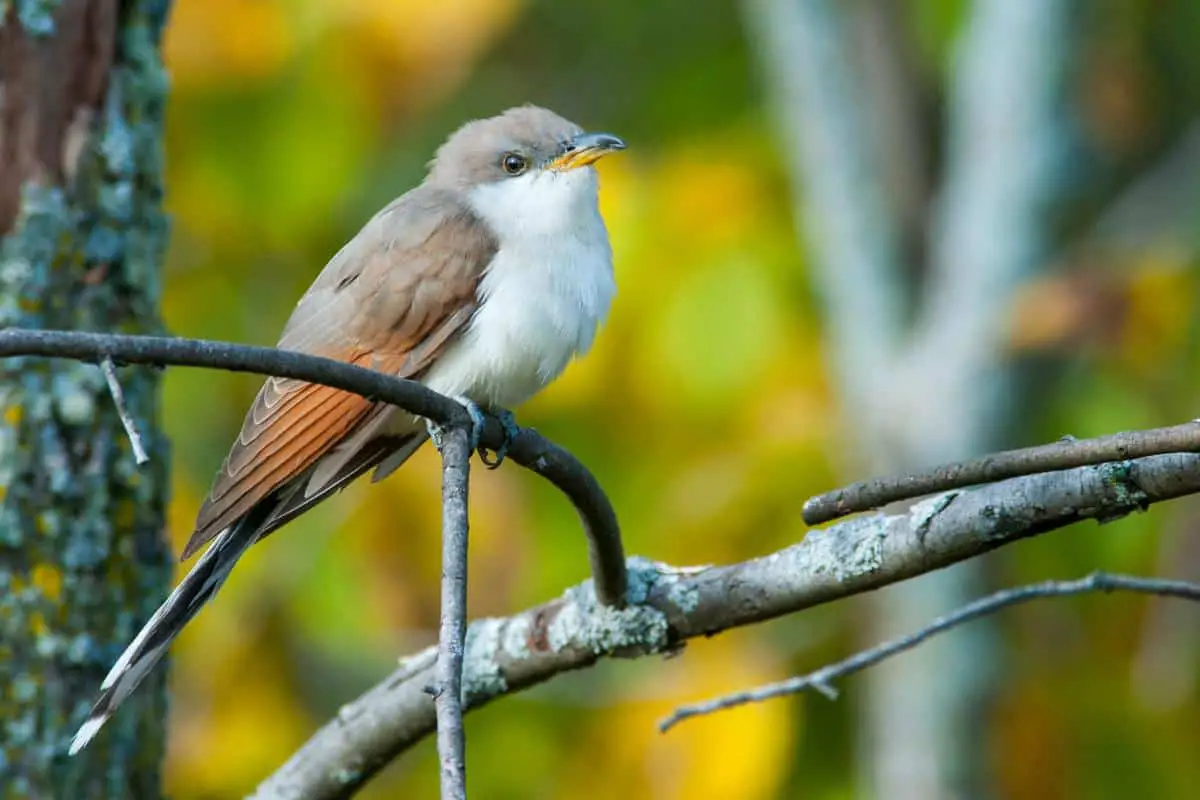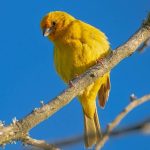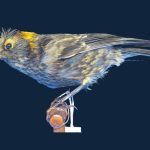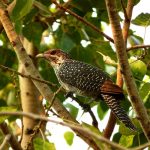Common Name: Yellow-billed Cuckoo
Scientific Name: Coccyzus americanus| Size | Diet | Range in Hawaii | Status in Hawaii |
|---|---|---|---|
| 11 in. | caterpillars, grasshoppers, and beetles | Unknown | Least Concern |
The Yellow-billed cuckoo (Coccyzus americanus) is a fascinating bird species known for its unique appearance and distinctive call. These birds are found throughout North and Central America during their breeding season and are often heard calling out their “ka-ka-ka-ka-ka-ka-kow-kow-kowlp!” call from the trees.
While they are not native to Hawaii, they have been spotted in the Northwestern Hawaiian Islands as non-breeding visitors and vagrants. With their striking appearance and melodic call, Yellow-billed cuckoos are a favorite among birdwatchers and nature enthusiasts.
In this article, we will explore the fascinating world of the Yellow-billed cuckoo, its unique adaptations, and the importance of conservation efforts to protect this species and its habitat.
Yellow-billed cuckoo
Appearance
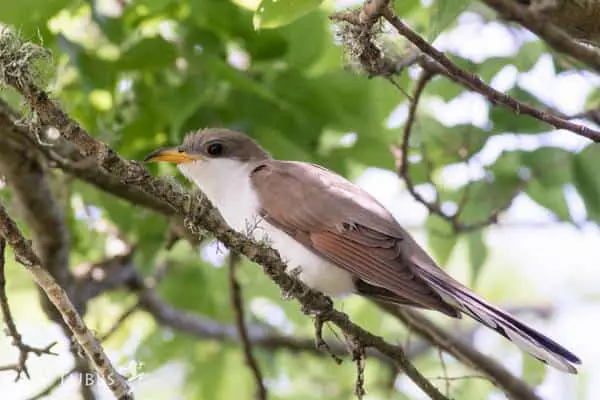
The Yellow-billed Cuckoo presents a truly remarkable sight with its striking appearance. Measuring around 11 inches in length, this medium-sized bird showcases a range of distinct features. Its slender body is adorned with soft, gray-brown plumage that allows it to effortlessly blend into the leafy canopies of its habitat.
However, it’s the cuckoo’s signature characteristic that truly steals the show—a vibrant yellow bill that stands out against its otherwise muted coloration. This eye-catching beak serves as a testament to the cuckoo’s uniqueness, making it instantly recognizable and a delight to behold for bird enthusiasts and nature lovers alike.
Diet
This avian species has a preference for a specialized menu that sets it apart from other birds. In particular, the Yellow-billed Cuckoo is known for its voracious appetite for insects. It has developed an impressive skill for catching its prey mid-air, often snatching flying insects such as caterpillars, grasshoppers, and beetles in acrobatic maneuvers.
Nesting
These resourceful birds prefer to build their nests in dense vegetation, often selecting trees and shrubs with thick foliage that provide ample cover and camouflage. Unlike many other birds, the cuckoo doesn’t construct an intricate nest from scratch. Instead, it repurposes existing structures or takes advantage of natural cavities, such as abandoned woodpecker holes or thick tangles of vines.
Once it finds a suitable location, the female Yellow-billed Cuckoo takes charge of nest-building. She weaves together a simple platform of twigs, creating a shallow cup-like structure. To provide extra camouflage, the outside of the nest may be adorned with leaves or foliage, helping it blend seamlessly into the surrounding foliage.
What’s truly fascinating about the Yellow-billed Cuckoo’s nesting behavior is its secretive and secretive nature. These birds are masters of concealment, often remaining silent and motionless when near their nests to avoid drawing attention to their vulnerable offspring. This secretive behavior, combined with their preference for dense vegetation, makes it challenging for researchers and birdwatchers to observe their nesting activities firsthand.
Once the nest is complete, the female will lay a clutch of 2 to 4 pale green eggs. Both the male and female share the responsibility of incubation, taking turns to keep the eggs warm. After about two weeks, the eggs hatch, and the parents continue to share the duties of feeding and caring for the chicks until they fledge and become independent.
Behavior
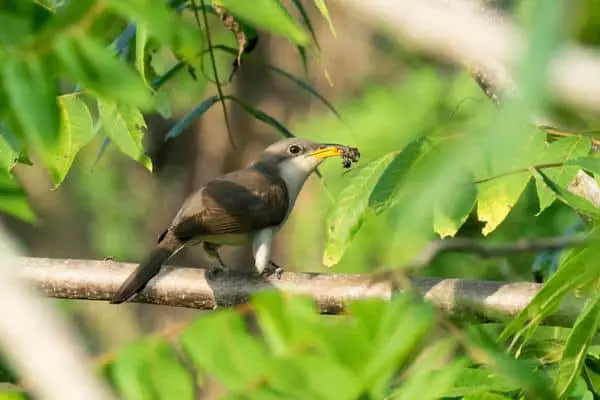
One remarkable behavior of the Yellow-billed Cuckoo is its feeding strategy. These skilled hunters have mastered the art of catching insects on the wing.
With astonishing agility, they swoop down from their perches to snatch insects mid-flight, displaying impressive aerial acrobatics. This ability allows them to capture a wide range of insects, including caterpillars, grasshoppers, and beetles, effectively controlling insect populations within their habitat.
Another notable behavior is their secretive nature. Yellow-billed Cuckoos are often elusive and skilled at remaining concealed within the dense foliage of their habitats. They are known for their silent and motionless behavior when near their nests or when perched, making it challenging for observers to detect their presence. Their ability to blend seamlessly into their surroundings enables them to avoid potential predators and increases their chances of successfully raising their young.
Furthermore, these cuckoos are known for their distinct vocalizations. Their calls consist of a series of low-pitched, hollow-sounding notes, often described as a rapid “coo-coo-coo-coo-coo-coo.” These unique calls serve as territorial signals and are also used during courtship displays, helping to attract potential mates.
During migration, Yellow-billed Cuckoos embark on remarkable journeys, covering thousands of miles between their breeding grounds in North America and their wintering habitats in Central and South America. They navigate vast landscapes, relying on their innate sense of direction to find suitable stopover sites for rest and refueling.
Habitat
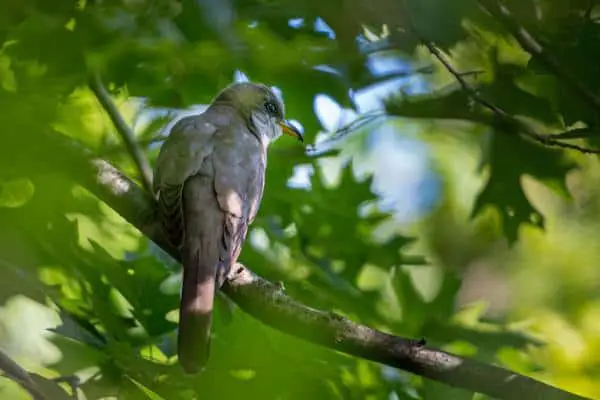
The Yellow-billed Cuckoo thrives in diverse habitats. During the breeding season, they inhabit deciduous and riparian forests with dense understory. In their wintering grounds, they adapt to tropical rainforests, woodlands, and scrubby habitats.
Range
According to the American Ornithological Union, the Yellow-billed cuckoo breeds throughout most of North America, from the southern United States to northern Mexico, as well as in the West Indies. During the winter months, they withdraw to northern South America. While they are not native to Hawaii, one Yellow-billed cuckoo was observed, described, and photographed at Laysan in the Northwestern Hawaiian Islands, making it a rare vagrant in the state.
Conservation Status
According to the IUCN Red List, the Yellow-billed Cuckoo is currently listed as a species of “Least Concern.” This classification suggests that the species is not currently at a high risk of extinction.
Interesting Facts
1. Brood parasitism
While not as common as in other cuckoo species, the Yellow-billed Cuckoo occasionally engages in brood parasitism. It may lay its eggs in the nests of other bird species, such as American Robins or Gray Catbirds, tricking them into raising its young.
2. Unusual Wing Shape
The cuckoo has long, pointed wings that contribute to its agile flight and allow it to maneuver through dense vegetation with ease.
3. Short Stay in Breeding Areas
Yellow-billed Cuckoos spend a relatively short time in their breeding areas, arriving in late spring and departing as early as July. This limited window is due to the availability of their preferred food sources, such as caterpillars.
4. Taxonomic Uncertainty
There is ongoing debate among experts about the taxonomy of the Yellow-billed Cuckoo. It is considered to be part of a species complex, with subspecies that vary slightly in appearance and behavior across their range.
5. Impressive Egg-laying Speed
The Yellow-billed Cuckoo is known for its rapid egg-laying. It can lay a single egg each day until it completes a clutch of 3 to 5 eggs. This remarkable ability allows for efficient reproduction within a short time frame.
Frequently Asked Questions
1. How long do Yellow-billed Cuckoos live?
The average lifespan of a Yellow-billed Cuckoo is around 6 to 7 years. However, some individuals have been known to live up to 10 years or more.
2. Are Yellow-billed Cuckoos social birds?
Yellow-billed Cuckoos are generally solitary birds, but they may interact with other cuckoos during migration or in suitable habitats where food resources are abundant. They may also engage in territorial disputes with conspecifics during the breeding season.
3. How can I attract Yellow-billed Cuckoos to my backyard?
Creating a habitat that mimics their natural preferences can help attract Yellow-billed Cuckoos to your backyard. Planting native trees and shrubs that provide dense foliage and a variety of insects can make your yard more attractive to these birds. However, it’s important to note that their presence may be influenced by local factors such as geographic range and habitat suitability.
4. Can I keep a Yellow-billed Cuckoo as a pet?
No, it is illegal to keep native wild birds like the Yellow-billed Cuckoo as pets in most countries. It is important to appreciate and admire these birds in their natural habitats and support conservation efforts to ensure their continued existence.
5. Do Yellow-billed Cuckoos have any cultural or historical significance?
Yellow-billed Cuckoos have cultural significance in some indigenous traditions and folklore. They are often associated with rain, fertility, and the changing seasons in certain Native American cultures. Their unique calls and secretive behavior have inspired stories and legends in various cultural contexts.
